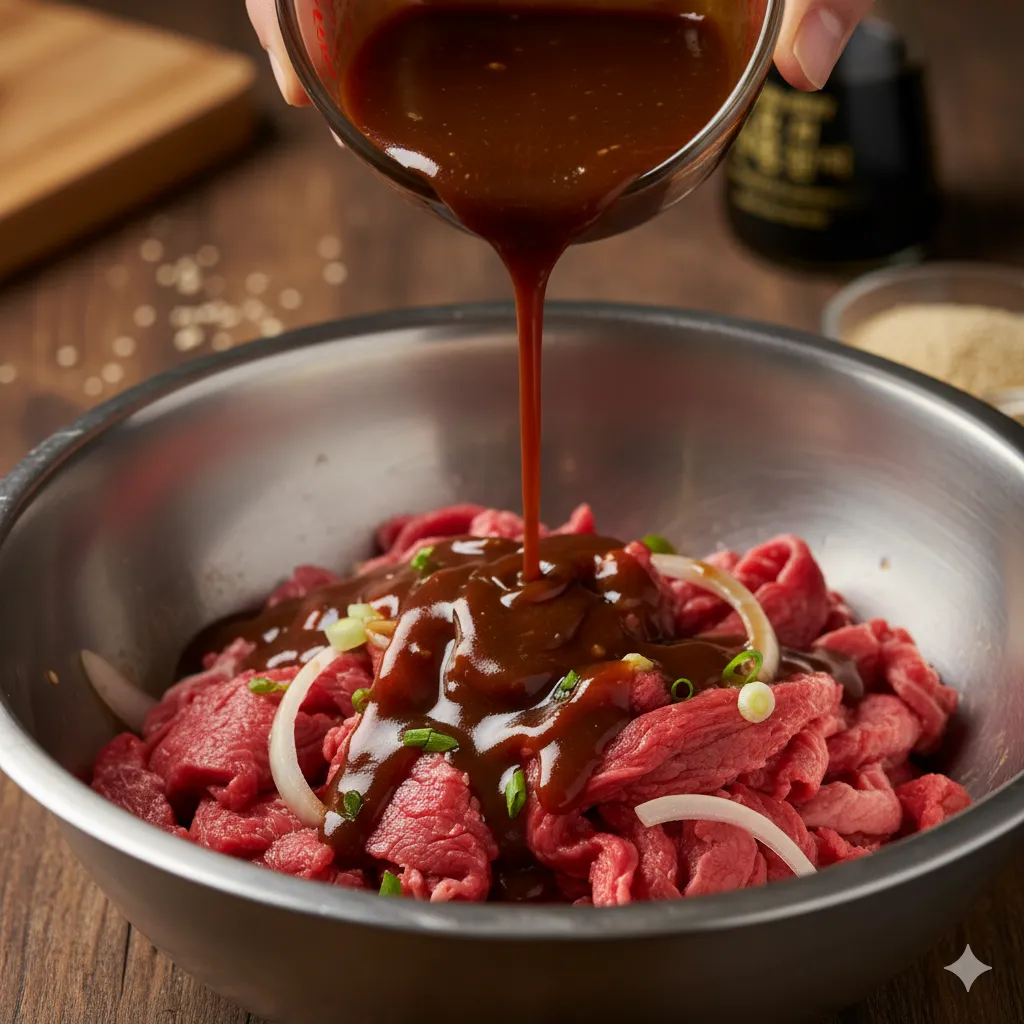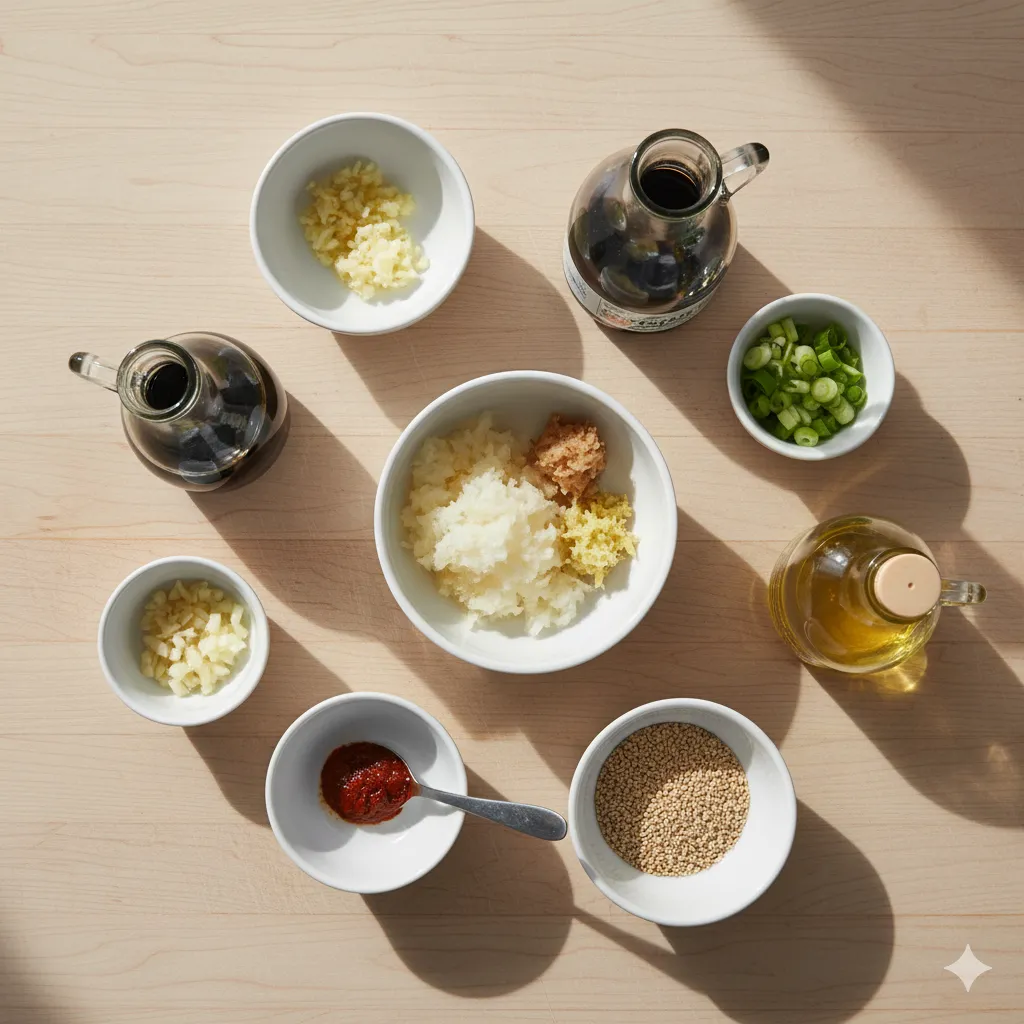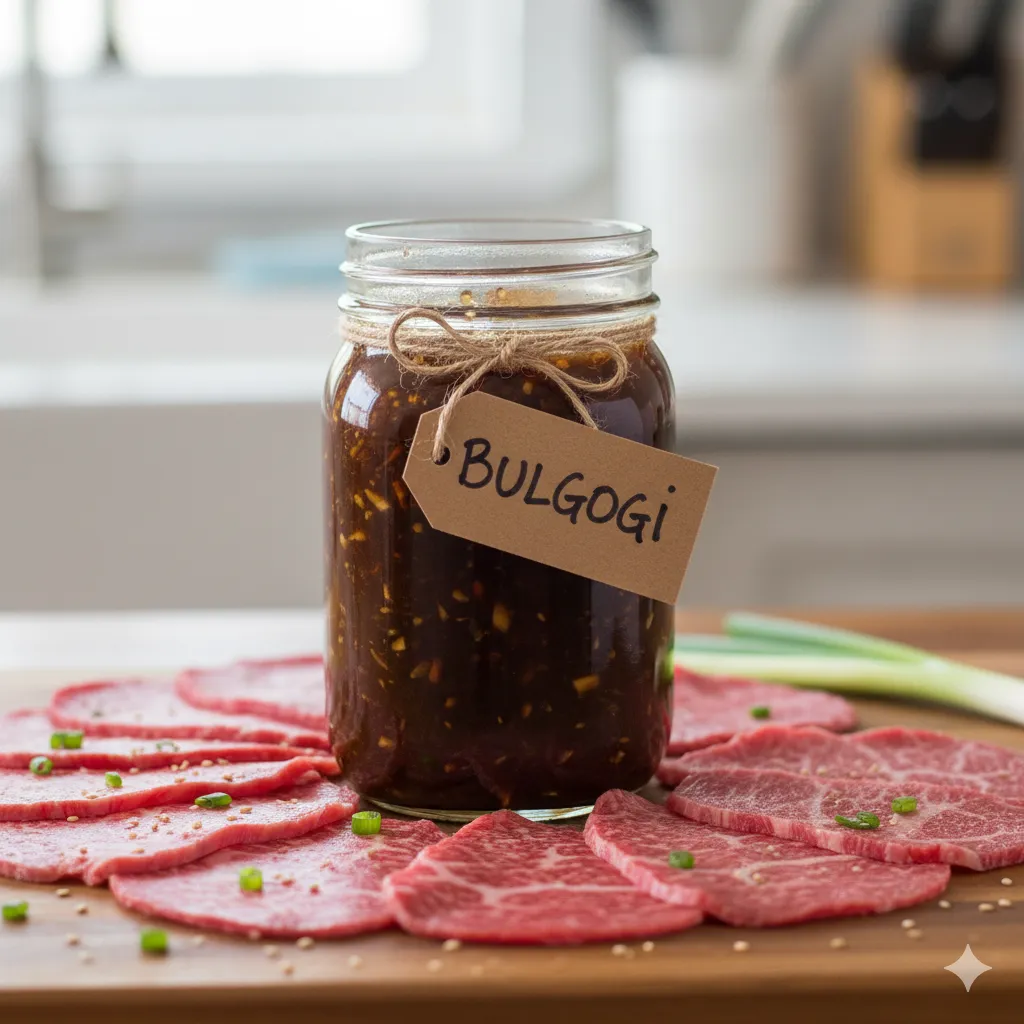
Bulgogi, meaning “fire meat,” is the most famous dish in Korean BBQ.
The secret to its incredible flavor isn’t the cut of beef—it’s the magical marinade: the **bulgogi sauce recipe** itself.
This recipe will show you how to create an authentic, powerful, and deeply savory marinade that balances sweetness, saltiness, and umami perfectly. It takes only five minutes to whisk together.
Forget the expensive bottled versions at the store. Homemade is always fresher, and you control the level of sweetness and spice.
This marinade isn’t just for beef; it works wonders on chicken, pork, and even vegetables. Master this sauce, and you’ve unlocked the door to incredible home-cooked Korean cuisine.
- Why You’ll Love This Recipe
- Ingredients
- Instructions
- You Must Know
- Storage Tips
- Ingredient Substitutions and Variations
- Serving Suggestions
- Cultural and Historical Notes
- Seasonal Adaptations
- Three Helpful Notes about This Recipe
- Success Stories
- Freezer Meal Conversion
- Pro Tips
- Common Recipe Questions
- What You’ll Need
- Steps to Follow
- Extra Handy Tips
- Tools You’ll Need
- Allergy Details
Why You’ll Love This Recipe

- **Authentic Flavor:** This is a true **korean bulgogi sauce recipe** that uses traditional fruit for natural sweetness and meat tenderizing.
- **Quick Prep:** Takes only 5 minutes of active time to blend, making it an excellent **quick recipes** addition.
- **Natural Tenderizer:** We use grated Asian pear or apple, which contains enzymes that naturally tenderize the meat for a melt-in-your-mouth texture.
- **Versatile:** Use this marinade for **beef bulgogi recipe**, chicken, tofu, or mushrooms.
Ingredients

The beauty of this **recipe bulgogi sauce** lies in its accessible ingredients.
- **The Base:** Soy sauce (Korean *Ganjang* is best, but any quality soy sauce works).
- **The Sweetener/Tenderizer:** Grated Asian pear, apple, or kiwi. These fruits add a mellow sweetness and, more importantly, enzymes.
- **Aromatics:** Freshly minced garlic and ginger. Do not use powdered!
- **The Kick:** Gochugaru (Korean chili flakes) for a subtle warmth, if desired, or black pepper.
- **Flavor Finishers:** Sesame oil for its distinct nutty aroma, and optional sesame seeds.
Instructions

1. Prepare the Fruit:
Peel and core your Asian pear or apple. Grate it finely using a box grater or pulse it in a small food processor until you have a smooth paste. This is essential for the texture and tenderizing properties of the **bulgogi sauce recipe**.
2. Combine Ingredients:
In a large mixing bowl, combine the soy sauce, grated fruit/paste, brown sugar, minced garlic, ginger, and sesame oil.
Add the optional gochugaru and black pepper now.
3. Whisk Until Smooth:
Whisk the sauce vigorously until the brown sugar is completely dissolved and the mixture is uniform. The sauce should be slightly thick and opaque due to the grated fruit.
4. Marinate the Meat:
Place your thinly sliced beef (ribeye or sirloin are ideal) in a large bowl.
Pour the prepared **bulgogi sauce** over the meat, tossing gently with your hands to ensure every slice is fully coated.
Marinate for at least 30 minutes, or preferably for 4 to 8 hours in the refrigerator for the best flavor infusion and tenderization.
5. Cook and Serve:
Grill the marinated meat over high heat on a grill, or pan-fry it in a hot skillet until caramelized and cooked through. Serve immediately over rice with a side of kimchi.
You Must Know
The true magic of an authentic **bulgogi sauce recipe** is not just the flavor combination but the enzymatic action of the grated fruit, which serves as a natural tenderizer; specifically, Asian pear contains proteolytic enzymes that break down the tough muscle fibers in the beef, resulting in the signature velvety, tender texture that makes bulgogi so renowned.
For this reason, you should avoid using canned or bottled pear/apple puree, as the heat treatment during preservation will deactivate the necessary enzymes, rendering them useless for tenderizing.
Furthermore, the marinating time is non-negotiable for maximizing both flavor and tenderness; while 30 minutes is the minimum required to coat the beef, marinating for at least four hours ensures the soy sauce, sugar, and aromatics fully penetrate the meat, and the fruit enzymes have ample time to do their work, preventing the meat from becoming tough or chewy when exposed to high heat.
If you are preparing a large batch of **korean bulgogi sauce recipe** in advance, you can keep the sauce base (without the fruit or meat) in the refrigerator for up to two weeks, only adding the fresh grated pear right before you are ready to marinate the meat to ensure the enzymes are fresh and potent for the best possible result, which is crucial for achieving the perfect **beef bulgogi korean** flavor and texture. You can learn more about the role of enzymes in meat tenderization from culinary science resources like The Exploratorium.
Storage Tips
The prepared **bulgogi sauce** (without the meat) can be stored in an airtight jar in the refrigerator for up to 2 weeks. The flavor will actually deepen slightly after a day or two.
If you’ve already marinated the meat, it should be cooked within 2 days.
Cooked bulgogi meat can be stored in the refrigerator for up to 4 days and reheated in a skillet.
Ingredient Substitutions and Variations
If you cannot find an Asian pear, a firm, crisp Bosc or Fuji apple is an acceptable substitute, and if you are completely out of fresh fruit, you can use a small piece of grated kiwi, which contains even more potent tenderizing enzymes, but be cautious with kiwi as over-marinating (more than 2 hours) can make the meat mushy due to its strength. Many variations of **authentic bulgogi sauce recipe** also include rice wine or *mirin* (sweet rice wine), which adds a pleasant aroma and depth of flavor; you can add a tablespoon or two if you have it on hand.
For a non-Korean sweet element, you can swap the brown sugar for maple syrup or honey, though this will slightly alter the final profile. The key is finding the right balance of savory, sweet, and aromatic notes, which is why the sesame oil, garlic, and ginger are non-negotiable.
If you want a vegetarian version of the marinade, try it with slices of firm tofu or portobello mushrooms, marinating for only 30 minutes. If you are looking for another incredible Korean favorite, be sure to try our Crispy Korean Kimchi Pancakes recipe!
Serving Suggestions
Bulgogi is traditionally served in a *ssam*—a Korean lettuce wrap.
Place a piece of cooked bulgogi on a leaf of fresh lettuce (such as red leaf or romaine), add a dollop of *ssamjang* (spicy dipping paste) or a little kimchi, wrap it up, and eat it in one bite.
Always serve your **korean bulgogi** with hot, fluffy white rice and a variety of *banchan* (small side dishes) like kimchi, seasoned spinach, and pickled radish.
Cultural and Historical Notes
Bulgogi is a testament to Korea’s long history of grilling. It originated in the Goguryeo era (37 BC–668 AD) as a dish called *maekjeok*, which was meat skewered and grilled.
The modern version, with its distinctive sweet and savory marinade, became popular during the Joseon dynasty (1392–1897).
It remains a staple of **korean bbq recipe** culture, symbolizing warmth, communal eating, and the complexity of Korean flavors.
Seasonal Adaptations
In the summer, serve the cooked bulgogi over a bed of chilled *naengmyeon* (cold buckwheat noodles) for a refreshing twist.
In the colder months, the marinated beef can be used in a hearty, savory *bulgogi jeongol* (beef and mushroom hot pot).
Adding a little more fresh ginger to the **bulgogi sauce recipe** in the winter can also create a warming effect.
Three Helpful Notes about This Recipe
- **Do Not Skip the Fruit:** The grated pear or apple is essential for tenderizing the beef; it’s more than just a sweetener.
- **Marinate Long:** Marinate for at least 4 hours—or up to 8—to achieve deep flavor penetration and the best tenderness.
- **High Heat Only:** Cook the bulgogi quickly over very high heat (grill or skillet) to ensure a beautiful caramelization without drying out the thin slices.
Success Stories
This **bulgogi sauce recipe** has been called a “game changer” by readers who were tired of overly salty or sugary store-bought versions. Many who searched for a reliable **korean bbq recipe** found that the subtle addition of fresh fruit was the secret they were missing to achieve restaurant-quality beef tenderness.
Home cooks frequently report that this marinade is so delicious, they started using it on other proteins, turning simple chicken or pork into a weeknight favorite. It is the perfect blend of savory and sweet, making it the most requested dish at family gatherings.
Freezer Meal Conversion
This is a great freezer meal! Marinate the thin beef slices in the prepared **bulgogi sauce** directly in a freezer-safe bag.
Squeeze out all the air, seal it, and freeze it flat for up to 3 months.
To cook, thaw the bag overnight in the refrigerator and then cook immediately as directed.
Pro Tips
- If you prefer a thicker sauce for brushing, you can gently simmer the sauce ingredients (excluding the fruit and meat) for 5 minutes before marinating.
- For maximum flavor, use a light-colored, low-sodium soy sauce.
- Always finish the cooked meat with a sprinkle of toasted sesame seeds for an authentic finish.
Common Recipe Questions
how to make bulgogi sauce recipe
To **how to make bulgogi sauce recipe**, blend a base of soy sauce, brown sugar, grated Asian pear (or apple), minced garlic, ginger, and sesame oil, then whisk until smooth and use to marinate thin slices of beef for at least four hours.
authentic bulgogi sauce recipe
An **authentic bulgogi sauce recipe** relies on the use of fresh, grated Asian pear or apple not just for sweetness but as a key ingredient for its natural enzymes that tenderize the thinly sliced beef.
recipe for bulgogi sauce
A reliable **recipe for bulgogi sauce** should balance the deep savory notes of soy sauce with the sweetness of fruit and sugar, while adding potent aromatics like garlic and ginger, and a final nutty note from sesame oil.
beef bulgogi korean
**Beef bulgogi korean** style is thinly sliced, marinated beef (typically sirloin or ribeye) that is cooked quickly over high heat, often grilled, which results in tender, caramelized, and intensely flavorful meat.
korean bbq recipe
A **korean bbq recipe** often focuses on a savory-sweet marinade, like bulgogi, and emphasizes very thin cuts of meat that are grilled quickly at the table, encouraging a communal and interactive dining experience.
What You’ll Need
→ The Base
1/2 cup soy sauce
1/4 cup brown sugar
1/2 cup grated Asian pear or apple (about 1 small pear)
→ Aromatics & Finishers
2 tbsp minced garlic
1 tbsp minced fresh ginger
2 tbsp sesame oil
1 tbsp rice wine or mirin (optional)
1 tsp black pepper
1/2 tsp gochugaru (Korean chili flakes, optional)
→ Tools
Mixing bowl
Whisk
Box grater or food processor
Steps to Follow
- Grate the Asian pear or apple into a bowl.
- Combine all sauce ingredients (soy sauce through gochugaru) in the bowl and whisk until sugar dissolves.
- Pour sauce over 1.5 lbs thinly sliced beef and marinate for 4-8 hours.
- Grill or pan-fry the meat quickly over high heat until cooked and slightly caramelized.
Extra Handy Tips
Always slice the meat against the grain for maximum tenderness. Partially freezing the meat helps with this.
If you don’t have fresh ginger, you can substitute with 1 teaspoon of ground ginger, though fresh is superior.
Taste the marinade before adding the meat; it should taste strong, as it needs to penetrate and season the meat.
Tools You’ll Need
- Mixing bowl
- Whisk
- Airtight jar for storage
Allergy Details
This **bulgogi sauce recipe** contains soy. It is naturally nut-free, dairy-free, and can be gluten-free if using Tamari or gluten-free soy sauce. It is important to verify ingredient labels and consult a healthcare professional if you have allergies.

